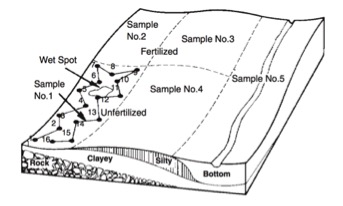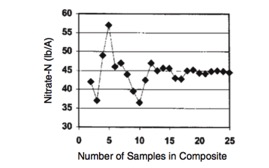Sample Collection
Obtaining valuable information from a soil test begins with collecting a good sample. What do I mean by a “good” sample? A good soil sample will be representative of the area being tested, composed of the proper number of cores, and collected at the proper depth. Various sampling strategies exist, including random composite, management zone or grid. For this article, we will focus on random composite sampling. Other articles on grid sampling andmanagement zones can be viewed at the IPNI website.
A random composite sample is just what it sounds like: The sample is composed of several cores collected in a random pattern, then mixed together and submitted as a single sample. To be representative of the area, it is best to avoid unusual spots in the field that are due to some uncontrolled factor such as field borders, old lime piles, sprayer or spreader fill areas, old fence rows, buildings, etc. If the unusual spot makes up a significant area of the field, then it should be sampled separately. Figure 1 illustrates a typical random sampling pattern.

Figure 1.Representation of a field divided into uniform areas and a random sampling pattern (Zhang and Arnall, 2015).
Note that the field in Figure 1 is divided into five different areas. In highly variable landscapes due to topography, changes in soil type, or knowledge of field variation in productivity, it is best to collect multiple composite samples. If the field is fairly uniform and no knowledge of variation exists, then a whole field sampling would be appropriate. Figure 1 also shows 16 cores being collected for sample number 1. Many university recommendations suggest that 15 to 20 cores per sample are adequate to represent the fertility in a sampled area ( Figure 2).

Figure 2. The minimum number of cores needed to make a representative composite soil sample is between 15 and 20 (Zhang and Arnall, 2015).
This number will increase if the field being sampled has residual fertilizer bands. The general recommendation is to double the number of cores. However, if the location of the previous bands is known, then local experts can often provide specific guidelines for the sampling strategy, depending on band spacing.
Proper sampling depth depends on various factors including tillage practices and cropping systems; most-soil testing facilities will provide local instructions regarding sample depth. The important point is to be consistent at any depth. Including cores taken shallower or deeper then recommended can enrich or dilute the nutrient content of the sample relative to the actual plant availability of the nutrient in the field, and affect the fertilizer recommendation.
It is also important to recognize that seasonal variability in soil nutrients does exist. To minimize the effect of temporal changes in nutrients, it is recommended to sample at the same time of year. Whether it is right after harvest or just before a preplant fertilizer application, the most important point is, again, to be consistent. Consistency in timing will help create a sampling history for the field that will be useful for analyzing trends in soil fertility and more useful for fertilizer decision-making.
Ensuring that a good sample is collected and submitted to the lab can alleviate much of the grower uncertainty about the accuracy of soil test reports. The adage “garbage in, garbage out” absolutely applies to soil testing.
Interpreting Soil Test Reports
Another very important component of soil testing to be consistent in is laboratory selection. I’ve had many growers over the years express concern over large changes in soil test reported values from year to year, and then they show me reports from two different labs. When I point this out, they then ask, “Well, which one is right?” Which one is “right” is hard to say based on one sample, but it is not hard to explain why they are different.
A soil test report basically contains two types of information: analytical results and fertilizer recommendations. The analytical results can differ, mainly due to differences in chemical extractants used. Various extractants are used to simulate the natural processes found in different types of soils. Some are particularly suited for certain soils, while others can be used on a range of soils, which can result in different labs using different extractants on the same soil. Both might be appropriate for the soil and good predictors of nutrient availability, but could result in considerably different numerical values on the report. Some equations have been developed to convert results of one method into another; however, the most important point is to ensure that the extractant being used is appropriate for the soil being tested. Other possible reasons for different analytical results (although much less likely) are problems with instrumentation or poor analytical techniques, both of which can be eliminated by choosing a reputable lab to begin with. One other point to be aware of when comparing soil test reports is that not all labs report analytical results using the same units. Some report in pounds per acre (lbs/A), while others will use parts per million (ppm), and some have generated their own “index” of availability.
Fertilizer recommendations might differ between soil test reports due to the recommendation philosophy of the lab. Two main approaches exist for using soil test results to develop fertility programs: (1) nutrient sufficiency and (2) build-maintenance.
For the sufficiency approach, the goal is to apply, on average, just enough fertilizer to maximize profitability in the year of application without considering future soil test values. The recommended rate will usually supply nutrient amounts sufficient to achieve about 90 to 95 percent of maximum yield. The recommended rate will exceed crop removal at very low soil test levels and approach zero as the soil test value reaches the critical level. Over time, using this method will result in soil test levels equilibrating in the low or medium categories and nutrient applications will be required each year.
In the build-maintenance approach, fertilizer rate recommendations are made to meet the nutrient requirement of the immediate crop and to raise soil test values to the critical level over a specified time period (which may vary among labs). Once the soil test value is raised to the critical level, only the amount of nutrient removed in the harvested crop is applied.
These different philosophical approaches can result in similar soil test analytical results having different fertilizer recommendations associated with them. Another possible difference is due to variation in calibration studies that determine the likelihood of crop response to fertilizer application at a given soil test level.
To ensure trustworthy soil test reporting, select a quality lab with reliable calibration data, understand the recommendation philosophy, and stay with the lab for several seasons.
Summary
Soil testing is our best tool for determining the amounts of plant-available nutrients in the soil and an important part of a 4R Nutrient Stewardship program. To ensure that the soil test results are reliable, consider these key points:
- Collect samples at the same time each year
- Collect samples from representative areas of the field
- Composite a sufficient number of cores in each sample to represent the fertility in the sampled area
- Sample to a consistent and appropriate depth
- Select and stay with a quality laboratory
- Understand the lab’s recommendation philosophy
Reference
Zhang, H., and B. Arnall. 2015. How to get a good soil sample. [Online]. Available at:http://soiltesting.okstate.edu/soil-sampling-and-testing/PSS-2207getagoodsoilsample.pdf. Verified 09/23/2015.